It's a curious discrepancy: many Prosumer wireless microphones prominently advertise "Smart Noise Reduction." Yet, when you look at high-end, dedicated systems used for film production, broadcasting, and professional location sound—such as the Saramonic K9 UHF Wireless Microphone System—the word "Noise Cancellation" is conspicuously absent. This isn't an oversight. It's a deliberate choice rooted in two fundamentally different philosophies.
The answer is: Consumer audio prioritizes "immediate intelligibility"; professional audio prioritizes "pristine source capture" and "post-production control."
The Core Conflict: Real-Time NR Limits Post-Production
Real-time noise cancellation (DSP/ANC) is by nature an irreversible and lossy algorithmic process. The device essentially makes an "irreversible verdict" on the audio the moment it is recorded.
In eliminating background noise, these algorithms often damage essential details of the voice (high-frequency harmonics, breathing cues) and introduce distinct digital artifacts—often called "underwater sound" or "electronic flavor." Once these details are algorithmically removed, they cannot be recovered in post-production.
The Professional Goal: RAW "Negative Film" Audio
The goal of a professional location sound mixer is to deliver an audio file that is a complete, dynamic "RAW negative." The more original and intact the sound, the more creative freedom the re-recording mixer has later.
In film, vital ambient cues—the distant rumble, the faint water drip, or the natural room reverb—are essential for atmosphere. A real-time NR system would indiscriminately filter out these cues, damaging the artistic vision. And most of time, professional systems would rather the initial sound capture be slightly "dirty" with recoverable details than "clean" with vital information permanently destroyed.

The Pro Strategy: Prevention is Better Than Reduction
Professional systems focus their efforts on "preventing noise from entering the system" and creating a massive "digital safety net" for the sound that does get in.
UHF Spectrum: Avoiding Noise at the Source
- Vlogger Systems: Tend to use the crowded 2.4 GHz digital band, which is prone to interference from Wi-Fi and Bluetooth.
- Professional Systems: Predominantly utilize the wider, less congested UHF Spectrum (typically the 470–600 MHz band). Features like True Diversity and automated scanning ensure the cleanest possible transmission, minimizing the system's own radio interference noise.
32-bit Float: The Digital Safety Net
Professional systems prioritize High Dynamic Range (HDR) as their primary defense against noise.
- The 32-bit Float Advantage: This recording format provides an immense digital headroom. It ensures that even if the input level is wildly misjudged—if an interviewee suddenly shouts—it is virtually impossible to clip the signal in the digital domain.
- Function: It eliminates digital clipping (the harshest type of noise) and guarantees that sounds are preserved perfectly for later processing, without being ruined by gain staging errors.
Hardware Excellence: Ultra-Low System Noise
Superior engineering is used to suppress internal noise:
- Features like low-noise preamplifiers and highly stable RF circuits ensure that the system's own electronic noise floor is pushed below the threshold of human hearing. For a deeper dive on this, see our article on how to understand microphone noise floor.
- On many professional sets using equipment like the Saramonic K9, if you mute the input and turn the headphone volume all the way up, you hear next to nothing—a testament to how successfully the inherent system noise has been engineered out.

The Right Place for NR: Post-Production
The true, effective noise reduction always happens in the studio.
The location sound mixer's job is singular: capture the most complete, high-fidelity source material. Post-production noise reduction is superior because it is precise and non-destructive:
- Customized Filtering: Mixers use spectral analysis to target and remove specific frequencies—for instance, only eliminating a 60 Hz electrical hum without affecting the human voice, or only removing AC noise while preserving room reverb.
- Non-Destructive Editing: All processing is done on copies, allowing for infinite adjustments and reversals without harming the original file.
Conclusion
When a professional wireless microphone system lacks a "Noise Cancellation" button, it is a commitment to quality, flexibility, and control. The best noise reduction is when you cannot hear the device's presence at all. Focus on capture, leave the processing to post. That is the true professional sound philosophy.
To learn more about the latest news from Saramonic, join in our official social media: Facebook, Youtube, Instagram, X, Facebook Group.
Frequently Asked Questions
If professional mics don't use real-time NR, how do they deal with environmental noise on set?
Professional sound mixers primarily deal with noise through prevention and capture rather than real-time processing. This involves using the quiet UHF spectrum to avoid wireless interference, employing high-quality physical wind protection (dead cats/blimps), and utilizing low-noise preamps. The goal is to capture the cleanest possible sound "as is," leaving the surgical removal of any remaining noise to the non-destructive software tools in post-production.
Does 32-bit Float recording eliminate microphone background self-noise (hiss)?
No. 32-bit Float recording provides an immense digital headroom that makes it virtually impossible to clip the signal (eliminating digital distortion). However, it does not eliminate the physical self-noise (or hiss) generated by the microphone's capsule and preamplifier, nor does it remove ambient environmental noise. It simply preserves those noises perfectly, ensuring that they can be safely reduced later in post without introducing new digital artifacts.
Are all modern wireless microphones switching to 2.4 GHz instead of UHF?
While many Prosumer and budget systems use the global 2.4 GHz band for convenience and range, traditional film/broadcast systems (like the Saramonic K9) rely heavily on the UHF band (470–600 MHz). This is because the UHF band is less congested by consumer electronics (Wi-Fi, Bluetooth), offering superior frequency stability and more reliable signal transmission—a non-negotiable requirement for professional applications.








.jpg)





